Vestrahorn Mountain is located in southeast Iceland, near the town of Höfn. It is a prominent mountain featuring two peaks, reaching an elevation of 425 metres (1,394 ft). The land was used by the first settlers (Irish monks) before they were enslaved by Viking invaders (c. 860). Vesturhorn Mountain has historical significance, and Stokksnes has natural beauty and a huge radar dome.
Geology of Vestrahorn
The mountain is composed primarily of gabbro, a dark, greenish-colored volcanic rock formed from intrusive lava flows from near the earth’s core. This super-heated lava formed 8–10 million years ago and cooled slowly over time, forming large crystals. The lower flanks of the mountain are covered by glacial moraines, gravel, and sand deposited by glaciers during the Ice Age.
The area around Vestrahorn Mountain is known for its geological features, including the nearby Lagarfljot Gorge and Vestfirðir Nature Reserve. It is also home to many species of birds, including the Arctic Tern and Gyrfalcon, as well as mammal species such as the Arctic Fox, Reindeer, and Muskox.
Every sand dune is made of black, volcanic sand. Walk to the east through the sand dunes, and you will come to the Stokksnes shore. The beach is mostly sandy. The coastline is shallow, so waves can come a long way inland and surprise you. On the beach, where the sand is wet from the regular waves, there is always a good reflection of Vestrahorn Mountain, even in windy weather. Further south, the sand meets stone, and there are loose rocks and small cliffs on the boundaries of the NATO base.
Sponsored
Stokksnes Point
Vestrahorn Mountain is best viewed from Stokksnes. Drive out towards the radar station (N.A.T.O. base) on a rough, washboard road, and you will be surrounded by grassy sand drifts. These sandy tussocks are formed by the very strong winds that are often felt at Stokksnes.
There is a charge to use the road up to Stokksnes, even though the government pays for it. The charge can be taken from your credit card in the ‘Viking Cafe’, which is actually a nice place to have a coffee and escape the cold. The toll charge is to protect Icelandic nature. Unfortunately, the grassy dunes are often trampled badly by heavy tourism, only to be corrected by strong wind storms. The owner of Vestrahorn Mountain does pay the God of Wind a commission, so your money is not going to waste.
Stokksnes has natural beauty and a huge radar dome. There is a huge variety of foreground to help you photograph the Vestrahorn mountain.
Down towards the sea, it is possible to get perfect reflections in the wet sand. This can be a very windy spot, so remember to bring some protection for your eyes before battling against the sand blasting. Be aware that there are large swells of sea coming onto this beach (see my video). Sand blasting is possible and extremely unpleasant. Be prepared with eye protection.

Getting to Vestrahorn
Finding Vestrahorn Mountain is easy if you know what you are looking for. If you are driving east from Jokulsarlon or Hali, the Icelandic ring road breaks. The road continues to the town of Hofn. To continue on the ring road, there is a left turn a couple of miles before Hofn and about a mile after Hofn Airport.
The LEFT TURN is easy to spot because there is a roadside stop with several information boards. The road is also marked with distances to Djupavik and Egistadir. The road passes a few horse farms and a picnic area. From here, you will see that the road disappears into a tunnel in the mountain. About 100 metres before the tunnel mouth, there is an unassuming RIGHT TURN onto a semi-gravel, winding road. This road leads to the Viking Cafe and then to Stokksnes and the N.A.T.O. station.
Small Group Ice Caving
Photo Tips
Vestrahorn is an excellent spot for photography, with its two peaks creating a dramatic backdrop and the landscapes taking on a striking contrast depending on the time of day and weather. The nearby beaches provide a variety of different scenery and excellent photo opportunities.
Just being at Vestrahorn Mountain will normally give you a bunch of competition-winning photos. With basic skills of composition, sharpness, and exposure in mind, it’s difficult to go wrong. My main approach is to keep my eye on the right side of the mountain. The peaks are much more interesting than at the other end.
Focal length is an important consideration. There are photos to be captured with a telephoto lens, but my choice has always been wide-angle. That final triangle on the eastern end of Vestrahorn Mountain fits tightly into 50-mm and doesn’t leave a lot of room for anything else.
This eastern end of Vestrahorn is easier to compose with the sea, and it has a distant landscape. In the photo below, Brunahorn Mountain appears to be joined to the bottom of Vestrahorn Mountain. In fact, Brunahorn Mountain with its “bat-shaped’ peaks is about half a mile beyond. Moving further east or 100 feet up in the air might have separated the two mountains visually.

Which Lenses?
Most of the photos in this post were taken at 24mm on a full-frame DSLR. 24-mm doesn’t quite capture the whole mountain from Stokksnes. If you want to capture the whole mountain, like those famous reflection shots, then I recommend using 21-mm or wider. As I already mentioned, Stokksnes can be very windy (like all of Iceland).
Strong Tripod
Consider a heavy tripod and maybe some protection for your camera. My rear screen actually has sand damage! Vestrahorn Mountain works better on a winter afternoon. At 3 p.m., your shadows will be upon the sand dunes, so consider starting at the beach and working back through the sand dunes as the Icelandic light gets softer.

Right to roam
Know your rights before you visit. The Allemannsrett is the right to roam on uncultivated land. It is an act rather than a law, and it is honoured in Scandinavian countries, including Iceland and Britain. In fact, you are allowed to walk without charge on the land around Vestrahorn and Stokksnes. As long as you respect private property and the N.A.T.O. station, you are protected by this ancient act.
Exercise caution because, regrettably, this does not imply that the local police will be on your side. According to my own experiences, the rights of a tourist will not cause the police to take harsh action against a local landowner. Even if nothing happens, aggressive behaviour should always be reported. The landowner is responsible for maintaining the road up the mountain and to Stokksnes, but the Icelandic government is responsible for paying for it. This indicates that the road is funded by the tourist tax you pay when visiting Iceland.
Viking Film Set
On the land below the mountain stands a Viking village, which was constructed and left behind by an Icelandic film company. Further round past the end of Vesturhorn is a small ship wreck.
Magic Cloth Video
I shot a few Magic Cloth Tutorials featuring Vestrahorn Mountain from Stokksness Beach. Watch me perform the Magic Cloth Technique when a huge wave rolls up the beach.
Find Hotels Near Vestrahorn




















